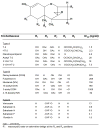Mechanisms of deoxynivalenol-induced gene expression and apoptosis
- PMID: 19238623
- PMCID: PMC2917199
- DOI: 10.1080/02652030802056626
Mechanisms of deoxynivalenol-induced gene expression and apoptosis
Abstract
Fusarium infection of agricultural staples such as wheat, barley and corn with concurrent production of deoxynivalenol (DON) and other trichothecene mycotoxins is an increasingly common problem worldwide. In addition to its emetic effects, chronic dietary exposure to DON causes impaired weight gain, anorexia, decreased nutritional efficiency and immune dysregulation in experimental animals. Trichothecenes are both immunostimulatory or immunosuppressive depending on dose, frequency and duration of exposure as well as type of immune function assay. Monocytes, macrophages, as well as T- and B-lymphocytes of the immune system can be cellular targets of DON and other trichothecenes. In vitro exposure to low trichothecene concentrations upregulates expression both transcriptionally and post-transcriptionally of cytokines, chemokines and inflammatory genes with concurrent immune stimulation, whereas exposure to high concentrations promotes leukocyte apoptosis with concomitant immune suppression. DON and other trichothecenes, via a mechanism known as the 'ribotoxic stress response', bind to ribosomes and rapidly activate mitogen-activated protein kinases (MAPKs). The latter are important transducers of downstream signalling events related to immune response and apoptosis. Using cloned macrophages, two critical upstream transducers of DON-induced MAPK activation have been identified. One transducer is double-stranded RNA (dsRNA)-activated protein kinase (PKR), a widely expressed serine/threonine protein kinase that can be activated by dsRNA, interferon and other agents. The other transducer is haematopoetic cell kinase (Hck), a non-receptor associated Src oncogene family kinase. Pharmacological inhibitors and gene suppression studies have revealed that Hck and PKR contribute to DON-induced gene expression and apoptosis. PKR, Hck and other kinases bind to the ribosome and are activated following DON interaction. Future studies will focus on the sequence of molecular events at the ribosome level that drive selective activation of these upstream kinases.
Figures



References
-
- Arnold DL, McGuire PF, Nera EA, Karpinski KF, Bickis MG, Zawidzka ZZ, Fernie S, Vesonder RF. The toxicity of orally administered deoxynivalenol (vomitoxin) in rats and mice. Food Chem Toxicol. 1986;24(9):935–941. - PubMed
-
- Atkinson HA, Miller K. Inhibitory effect of deoxynivalenol, 3-acetyldeoxynivalenol and zearalenone on induction of rat and human lymphocyte proliferation. Toxicol Lett. 1984;23(2):215–221. - PubMed
-
- Azcona-Olivera JI, Ouyang Y, Murtha J, Chu FS, Pestka JJ. Induction of cytokine mRNAs in mice after oral exposure to the trichothecene vomitoxin (deoxynivalenol): relationship to toxin distribution and protein synthesis inhibition. Toxicol Appl Pharmacol. 1995a;133(1):109–120. - PubMed
Publication types
MeSH terms
Substances
Grants and funding
LinkOut - more resources
Full Text Sources
Miscellaneous
